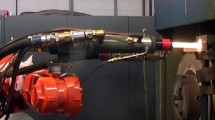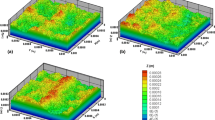Abstract
The coating buildup process of Al2O3/TiO2 ceramic powder deposited on stainless-steel substrate by atmospheric plasma spraying has been simulated by creating thermomechanical finite element models that utilize element death and birth techniques in ANSYS commercial software and self-developed codes. The simulation process starts with side-by-side deposition of coarse subparts of the ceramic layer until the entire coating is created. Simultaneously, the heat flow into the material, thermal deformation, and initial quenching stress are computed. The aim is to be able to predict—for the considered spray powder and substrate material—the development of residual stresses and to assess the risk of coating failure. The model allows the prediction of the heat flow, temperature profile, and residual stress development over time and position in the coating and substrate. The proposed models were successfully run and the results compared with actual residual stresses measured by the hole drilling method.













Similar content being viewed by others
References
F.-W. Bach, A. Laarmann, T. Wenz, and C.B. Nakhosteen, Modern Surface Technology, Wiley, London, 2006
J.R. Davis & Associates, ASM International, and Thermal Spray Society Training Committee, Handbook of Thermal Spray Technology, ASM International, New York, 2004
S. Hao, C.-J. Li, and G.-J. Yang, Influence of Deposition Temperature on the Microstructures and Properties of Plasma-Sprayed Al2O3 Coatings, J. Therm. Spray Technol., 2011, 20(1-2), p 160-169
R.B. Heimann, Plasma-Spray Coating: Principles and Applications, VCH, Tokyo, 1996
E. Lugscheider and K. Seemann, Prognose von Schichteigenschaften mittels neuronaler Netze, Neue Materialien und Verfahren in der Beschichtungstechnik, Univ.-Prof. Dr.-lng. habil. B.Wielage, Ed., 30 September bis 1 Oktober 2004
A. Behera and S.C. Mishra, Prediction and Analysis of Deposition Efficiency of Plasma Spray Coating Using Artificial Intelligence Method, OJCM, 2012, 02(02), p 54-60
M. Pasandideh-Fard, S. Chandra, and J. Mostaghimi, A Three-Dimensional Model of Droplet Impact and Solidification, Int. J. Heat Mass Transf., 2002, 45(11), p 2229-2242
S. Kamnis, S. Gu, T.J. Lu, and C. Chen, Numerical Modelling of Sequential Droplet Impingements, J. Phys. D: Appl. Phys., 2008, 41(16), p 165303
Jens Prehm, Coupled Coating Formation Simulation in Thermal Spray Processes Using CFD and FEM, CFD Lett., 2011, 3(2), p 2011
J. Zimmerman, Z. Lindemann, D. Golański, and W. Włosiński, Modeling Residual Stresses Generated in Ti Coatings Thermally Sprayed on Al2O3 Substrates, Bull. Pol. Acad. Sci. Tech. Sci., 2013, 61(2), p 515–525. doi:10.2478/bpasts-2013-0051
X.C. Zhang, B.S. Xu, H.D. Wang, and Y.X. Wu, Modeling of the Residual Stresses in Plasma-Spraying Functionally Graded ZrO2/NiCoCrAlY Coatings Using Finite Element Method, Mater. Des., 2006, 27(4), p 308-315
S. Guessasma, G. Montavon, and C. Coddet. On the Neural Network Concept to Describe the Thermal Spray Deposition Process: An Introduction. Proc. of Therm. Spray 2002: Int. Therm. Spray Conf. (DVS-ASM), ASM International, 2002, p 435–439
R. Ghafouri-Azar, J. Mostaghimi, S. Chandra, and M. Charmchi, A Stochastic Model to Simulate the Formation of a Thermal Spray Coating, J. Therm. Spray Technol., 2003, 12(1), p 53-69
L. Wu, J. Zhu, and H. Xie, Numerical and Experimental Investigation of Residual Stress in Thermal Barrier Coatings During APS Process, J. Therm. Spray Technol., 2014, 23(4), p 653-665
B.S. Yilbas and A. Arif, Residual Stress Analysis For HVOF Diamalloy 1005 Coating on Ti-6Al-4V Alloy, Surf. Coat. Technol., 2007, 202(3), p 559-568
P. Bansal, P. Shipway, and S. Leen, Residual Stresses in High-Velocity Oxy-Fuel Thermally Sprayed Coatings—Modelling the Effect of Particle Velocity and Temperature During the Spraying Process, Acta Mater., 2007, 55(15), p 5089-5101
D.W. Seo and E.G. Na, Finite Element Analysis of Residual Stress in NiCrAlY/Yttria-Stabilized Zirconia Coatings By Nanoscale Multi-Layered Deposition, KEM, 2004, 270-273, p 58-63
M. Ranjbar-Far, J. Absi, S. Shahidi, and G. Mariaux, Impact of the Non-Homogenous Temperature Distribution and the Coatings Process Modeling on the Thermal Barrier Coatings System, Mater. Des., 2011, 32(2), p 728-735
J. Stokes and L. Looney, FEA of Residual Stress During HVOF Thermal Spraying, J. Mater. Eng. Perform., 2009, 18(1), p 21-25
P. Bengtsson and C. Persson, Modelled and Measured Residual Stresses in Plasma Sprayed Thermal Barrier Coatings, Surf. Coat. Technol., 1997, 92(1-2), p 78-86
T. Valente, C. Bartuli, M. Sebastiani, and F. Casadei, Finite Element Analysis of Residual Stress in Plasma-Sprayed Ceramic Coatings, Proc. Inst. Mech. Eng. Part L: J. Mater. Des. Appl., 2004, 218(4), p 321-330
M. Wenzelburger, Modeling of Thermally Sprayed Coatings on Light Metal Substrates—Layer Growth and Residual Stress Formation, Surf. Coat. Technol., 2004, 180-181, p 429-435
Z. Gan, H.W. Ng, and A. Devasenapathi, Deposition-Induced Residual Stresses in Plasma-Sprayed Coatings, Surf. Coat. Technol., 2004, 187(2-3), p 307-319
H.W. Ng and Z. Gan, A Finite Element Analysis Technique For Predicting As-Sprayed Residual Stresses Generated By the Plasma Spray Coating Process, Finite Elem. Anal. Des., 2005, 41(13), p 1235-1254
H. Samadi and T.W. Coyle, Modeling the Build-Up of Internal Stresses in Multilayer Thick Thermal Barrier Coatings, J. Therm. Spray Technol., 2009, 18(5-6), p 996-1003
L. Wang, Y. Wang, X.G. Sun, J.Q. He, Z.Y. Pan, and C.H. Wang, Finite Element Simulation of Residual Stress of Double-Ceramic-Layer La2Zr2O7/8YSZ Thermal Barrier Coatings Using Birth and Death Element Technique, Comput. Mater. Sci., 2012, 53(1), p 117-127
L. Wang, Y. Wang, W.Q. Zhang, X.G. Sun, J.Q. He, Z.Y. Pan, and C.H. Wang, Finite Element Simulation of Stress Distribution and Development in 8Ysz and Double-Ceramic-Layer La2Zr2O7/8YSZ Thermal Barrier Coatings During Thermal Shock, Appl. Surf. Sci., 2012, 258(8), p 3540-3551
S. Widjaja, A.M. Limarga, and T.H. Yip, Modeling of Residual Stresses in a Plasma-Sprayed Zirconia/Alumina Functionally Graded-Thermal Barrier Coating, Thin Solid Films, 2003, 434(1-2), p 216-227
F. Hugot, J. Patru, P. Fauchais, and L. Bianchi, Modeling of a Substrate Thermomechanical Behavior During Plasma Spraying, J. Mater. Process. Technol., 2007, 190(1-3), p 317-323
R. Gadow, M.J. Riegert-Escribano, and M. Buchmann, Residual Stress Analysis in Thermally Sprayed Layer Composites, Using the Hole Milling and Drilling Method, J. Therm. Spray Technol., 2005, 14(1), p 100-108
P. Fauchais, Understanding Plasma Spraying, J. Phys. D: Appl. Phys., 2004, 37(9), p R86-R108
Ansys Inc., Ansys Documentation, Version 12, 2009.
D. Stamenković and I. Vasović, Finite Element Analysis of Residual Stress in Butt Welding Two Similar Plates, Sci. Tech. Rev., 2009, 59(1), p 57-60
K. Shinoda, H. Murakami, S. Kuroda, K. Takehara, and S. Oki, In Situ Visualization of Impacting Phenomena of Plasma-Sprayed Zirconia: From Single Splat to Coating Formation, J. Therm. Spray Technol., 2008, 17(5-6), p 623-630
A. Candel and R. Gadow, Optimized Multiaxis Robot Kinematic for HVOF Spray Coatings on Complex Shaped Substrates, Surf. Coat. Technol., 2006, 201(5), p 2065-2071
E28 Committee, Test Method for Determining Residual Stresses By the Hole-Drilling Strain-Gage Method, E28 Committee, West Conshohocken, PA.
R. Gadow, Advanced Ceramics and Composites, Expert, Rennes, 2000
D. Fang, S. Deng, H. Liao, and C. Coddet, Automatic Generation of Robot Trajectory For Free-Form Surfaces in Thermal Spraying, Proc. of the Int. Therm. Spray Conf. (DVS-ASM), 1 September, 2011, p 1110-1114.
Author information
Authors and Affiliations
Corresponding author
Additional information
This article is an invited paper selected from presentations at the 2015 International Thermal Spray Conference, held May 11-14, 2015, in Long Beach, CA, USA, and has been expanded from the original presentation.
Rights and permissions
About this article
Cite this article
Elhoriny, M., Wenzelburger, M., Killinger, A. et al. Finite Element Simulation of Residual Stress Development in Thermally Sprayed Coatings. J Therm Spray Tech 26, 735–744 (2017). https://doi.org/10.1007/s11666-017-0538-5
Received:
Revised:
Published:
Issue Date:
DOI: https://doi.org/10.1007/s11666-017-0538-5




